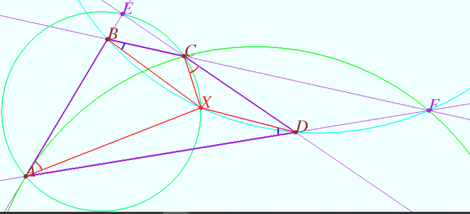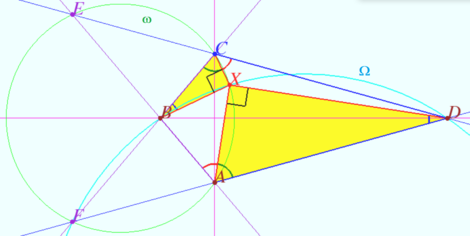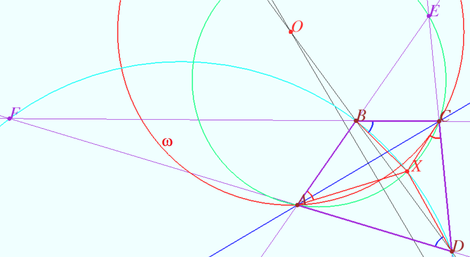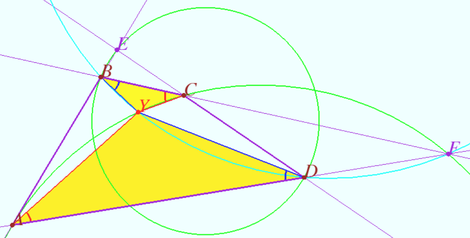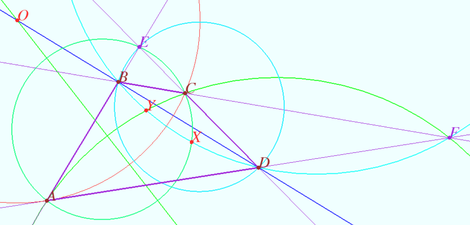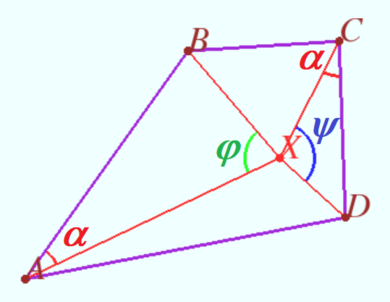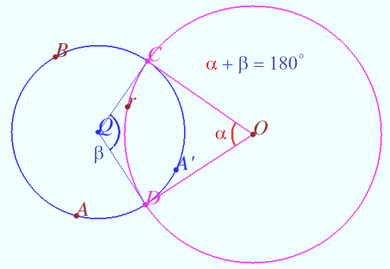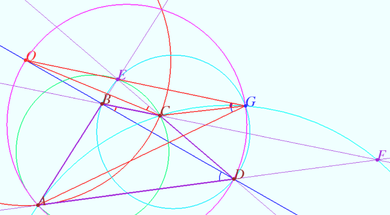Difference between revisions of "2018 IMO Problems/Problem 6"
(→Solution) |
|||
| (3 intermediate revisions by one other user not shown) | |||
| Line 1: | Line 1: | ||
| + | ==Problem== | ||
| + | |||
A convex quadrilateral <math>ABCD</math> satisfies <math>AB\cdot CD=BC \cdot DA.</math> Point <math>X</math> lies inside | A convex quadrilateral <math>ABCD</math> satisfies <math>AB\cdot CD=BC \cdot DA.</math> Point <math>X</math> lies inside | ||
<math>ABCD</math> so that | <math>ABCD</math> so that | ||
| Line 39: | Line 41: | ||
<i><b>Common case </b></i> | <i><b>Common case </b></i> | ||
| − | Denote by <math>O</math> the intersection point of <math>BD</math> and the perpendicular bisector of <math>AC.</math> Let <math>\omega</math> be a circle (red) with center <math>O</math> and radius <math>OA | + | Denote by <math>O</math> the intersection point of <math>BD</math> and the perpendicular bisector of <math>AC.</math> Let <math>\omega</math> be a circle (red) with center <math>O</math> and radius <math>OA = R.</math> |
| − | The points <math>B</math> and <math>D</math> are symmetric with respect to | + | We will prove <math>\sin\angle BXA =\sin \angle DXC</math> using point <math>Y</math> symmetric to <math>X</math> with respect to <math>\omega.</math> |
| + | |||
| + | The points <math>B</math> and <math>D</math> are symmetric with respect to <math>\omega</math> <i><b>(Claim 1).</b></i> | ||
The circles <math>BDF</math> and <math>BDE</math> are orthogonal to the circle <math>\omega</math> <i><b>(Claim 2).</b></i> | The circles <math>BDF</math> and <math>BDE</math> are orthogonal to the circle <math>\omega</math> <i><b>(Claim 2).</b></i> | ||
| Line 57: | Line 61: | ||
The points <math>X</math> and <math>Y</math> are symmetric with respect to the circle <math>\omega</math>, since they lie on the intersection of the circles <math>ACF</math> and <math>ACE</math> symmetric with respect to <math>\omega</math> and the circle <math>BDF</math> orthogonal to <math>\omega.</math> | The points <math>X</math> and <math>Y</math> are symmetric with respect to the circle <math>\omega</math>, since they lie on the intersection of the circles <math>ACF</math> and <math>ACE</math> symmetric with respect to <math>\omega</math> and the circle <math>BDF</math> orthogonal to <math>\omega.</math> | ||
| − | |||
| − | |||
| − | |||
The point <math>B</math> is symmetric to <math>D</math> with respect to <math>\omega \implies</math> | The point <math>B</math> is symmetric to <math>D</math> with respect to <math>\omega \implies</math> | ||
<cmath>\triangle OBC \sim \triangle OCD \implies \frac {OB}{OC} = \frac {BC}{CD} = \frac {OC}{OD},</cmath> | <cmath>\triangle OBC \sim \triangle OCD \implies \frac {OB}{OC} = \frac {BC}{CD} = \frac {OC}{OD},</cmath> | ||
| Line 66: | Line 67: | ||
<cmath>\frac {BX}{DY} = \frac {R^2}{OD \cdot OY} ,\frac {DX}{BY} = \frac{R^2}{OB \cdot OY}.</cmath> | <cmath>\frac {BX}{DY} = \frac {R^2}{OD \cdot OY} ,\frac {DX}{BY} = \frac{R^2}{OB \cdot OY}.</cmath> | ||
<cmath>\frac{BX}{DX} =\frac{DY}{BY} \cdot \frac {OB}{OD} = \frac{AD}{BC} \cdot \frac{BC}{CD} \cdot \frac{AB}{AD} = \frac{AB}{CD}.</cmath> | <cmath>\frac{BX}{DX} =\frac{DY}{BY} \cdot \frac {OB}{OD} = \frac{AD}{BC} \cdot \frac{BC}{CD} \cdot \frac{AB}{AD} = \frac{AB}{CD}.</cmath> | ||
| − | [[File:2018 IMO 6 angles.png| | + | [[File:2018 IMO 6 angles.png|390px|right]] |
| − | [[File:2018 IMO 6 Claim 3.png| | + | [[File:2018 IMO 6 Claim 3.png|390px|right]] |
| − | [[File:2018 IMO 6a.png| | + | [[File:2018 IMO 6a.png|390px|right]] |
Denote <math>\angle XAB = \angle XCD = \alpha, \angle BXA = \varphi, \angle DXC = \psi.</math> | Denote <math>\angle XAB = \angle XCD = \alpha, \angle BXA = \varphi, \angle DXC = \psi.</math> | ||
| Line 81: | Line 82: | ||
<math>CD \cdot BC = AB \cdot AD \implies AD = CD, AB = BC.</math> This is a special case. | <math>CD \cdot BC = AB \cdot AD \implies AD = CD, AB = BC.</math> This is a special case. | ||
| − | In all other cases, the equality of the sines follows <math> | + | In all other cases, the equality of the sines follows <math>\varphi + \psi = 180^\circ .</math> |
<i><b>Claim 1</b></i> Let <math>A, C,</math> and <math>E</math> be arbitrary points on a circle <math>\omega, l</math> be the perpendicular bisector to the segment <math>AC.</math> Then the straight lines <math>AE</math> and <math>CE</math> intersect <math>l</math> at the points <math>B</math> and <math>D,</math> symmetric with respect to <math>\omega.</math> | <i><b>Claim 1</b></i> Let <math>A, C,</math> and <math>E</math> be arbitrary points on a circle <math>\omega, l</math> be the perpendicular bisector to the segment <math>AC.</math> Then the straight lines <math>AE</math> and <math>CE</math> intersect <math>l</math> at the points <math>B</math> and <math>D,</math> symmetric with respect to <math>\omega.</math> | ||
| − | |||
<i><b>Claim 2</b></i> Let points <math>B</math> and <math>D</math> be symmetric with respect to the circle <math>\omega.</math> Then any circle <math>\Omega</math> passing through these points is orthogonal to <math>\omega.</math> | <i><b>Claim 2</b></i> Let points <math>B</math> and <math>D</math> be symmetric with respect to the circle <math>\omega.</math> Then any circle <math>\Omega</math> passing through these points is orthogonal to <math>\omega.</math> | ||
| Line 93: | Line 93: | ||
<i><b>Lemma</b></i> The opposite sides of the quadrilateral <math>ABCD</math> intersect at points <math>E</math> and <math>F</math> (<math>E</math> lies on <math>AB</math>). The circle <math>\omega</math> centered at the point <math>O</math> contains the ends of the diagonal <math>AC.</math> The points <math>B</math> and <math>D</math> are symmetric with respect to the circle <math>\omega</math> (in other words, the inversion with respect to <math>\omega</math> maps <math>B</math> into <math>D).</math> Then the circles <math>ACE</math> and <math>ACF</math> are symmetric with respect to <math>\omega.</math> | <i><b>Lemma</b></i> The opposite sides of the quadrilateral <math>ABCD</math> intersect at points <math>E</math> and <math>F</math> (<math>E</math> lies on <math>AB</math>). The circle <math>\omega</math> centered at the point <math>O</math> contains the ends of the diagonal <math>AC.</math> The points <math>B</math> and <math>D</math> are symmetric with respect to the circle <math>\omega</math> (in other words, the inversion with respect to <math>\omega</math> maps <math>B</math> into <math>D).</math> Then the circles <math>ACE</math> and <math>ACF</math> are symmetric with respect to <math>\omega.</math> | ||
| − | <i><b>Proof</b></i> We will prove that the point <math>G,</math> symmetric to the point <math>E</math> with respect to <math>\omega,</math> belongs to the circle <math>ACF | + | <i><b>Proof</b></i> We will prove that the point <math>G,</math> symmetric to the point <math>E</math> with respect to <math>\omega,</math> belongs to the circle <math>ACF</math> becouse <math>\angle AGC = \angle AFC.</math> |
| − | A circle <math>BDE</math> containing points <math>B</math> and <math>D</math> symmetric with respect to <math>\omega,</math> is orthogonal to <math>\omega</math> (Claim | + | A circle <math>BDE</math> containing points <math>B</math> and <math>D</math> symmetric with respect to <math>\omega,</math> is orthogonal to <math>\omega</math> <i><b>(Claim 2)</b></i> and maps into itself under inversion with respect to the circle <math>\omega.</math> Hence, the point <math>E</math> under this inversion passes to some point <math>G,</math> of the same circle <math>BDE.</math> |
A straight line <math>ABE</math> containing the point <math>A</math> of the circle <math>\omega,</math> under inversion with respect to <math>\omega,</math> maps into the circle <math>OADG.</math> Hence, the inscribed angles of this circle are equal <math>\angle ADB = \angle AGE.</math> | A straight line <math>ABE</math> containing the point <math>A</math> of the circle <math>\omega,</math> under inversion with respect to <math>\omega,</math> maps into the circle <math>OADG.</math> Hence, the inscribed angles of this circle are equal <math>\angle ADB = \angle AGE.</math> | ||
| Line 103: | Line 103: | ||
'''vladimir.shelomovskii@gmail.com, vvsss''' | '''vladimir.shelomovskii@gmail.com, vvsss''' | ||
| + | |||
| + | |||
| + | ==See Also== | ||
| + | |||
| + | {{IMO box|year=2018|num-b=5|after=Last Problem}} | ||
Latest revision as of 00:47, 19 November 2023
Problem
A convex quadrilateral ![]() satisfies
satisfies ![]() Point
Point ![]() lies inside
lies inside
![]() so that
so that
![]() and
and ![]() Prove that
Prove that ![]()
Solution
We want to find the point ![]() Let
Let ![]() and
and ![]() be the intersection points of
be the intersection points of ![]() and
and ![]() and
and ![]() and
and ![]() respectively.
The poinx
respectively.
The poinx ![]() is inside
is inside ![]() so points
so points ![]() follow in this order.
follow in this order.
![]()
![]() is cyclic
is cyclic ![]() lie on circle
lie on circle ![]()
Similarly, ![]() lie on circle
lie on circle ![]()
Point ![]() is the point of intersection of circles
is the point of intersection of circles ![]() and
and ![]()
Special case
Let ![]() and
and ![]()
The points ![]() and
and ![]() are symmetric with respect to the circle
are symmetric with respect to the circle ![]() (Claim 1).
(Claim 1).
The circle ![]() is orthogonal to the circle
is orthogonal to the circle ![]() (Claim 2).
(Claim 2).
![]() of
of ![]()
![]() of
of ![]()
![]() (Claim 3)
(Claim 3) ![]()
![]()
Similarly, ![]()
![]()
Common case
Denote by ![]() the intersection point of
the intersection point of ![]() and the perpendicular bisector of
and the perpendicular bisector of ![]() Let
Let ![]() be a circle (red) with center
be a circle (red) with center ![]() and radius
and radius ![]()
We will prove ![]() using point
using point ![]() symmetric to
symmetric to ![]() with respect to
with respect to ![]()
The points ![]() and
and ![]() are symmetric with respect to
are symmetric with respect to ![]() (Claim 1).
(Claim 1).
The circles ![]() and
and ![]() are orthogonal to the circle
are orthogonal to the circle ![]() (Claim 2).
(Claim 2).
Circles ![]() and
and ![]() are symmetric with respect to the circle
are symmetric with respect to the circle ![]() (Lemma).
(Lemma).
Denote by ![]() the point of intersection of circles
the point of intersection of circles ![]() and
and ![]()
Quadrangle ![]() is cyclic
is cyclic ![]()
Quadrangle ![]() is cyclic
is cyclic ![]()
The triangles ![]() by two angles, so
by two angles, so ![]()
The points ![]() and
and ![]() are symmetric with respect to the circle
are symmetric with respect to the circle ![]() , since they lie on the intersection of the circles
, since they lie on the intersection of the circles ![]() and
and ![]() symmetric with respect to
symmetric with respect to ![]() and the circle
and the circle ![]() orthogonal to
orthogonal to ![]()
The point ![]() is symmetric to
is symmetric to ![]() with respect to
with respect to ![]()
![]()
![]() The point
The point ![]() is symmetric to
is symmetric to ![]() and the point
and the point ![]() is symmetric to
is symmetric to ![]() with respect to
with respect to ![]() hence
hence
![]()
![]()
Denote ![]()
By the law of sines for ![]() we obtain
we obtain ![]()
By the law of sines for ![]() we obtain
we obtain ![]()
Hence we get ![]()
If ![]() then
then ![]()
![]() This is a special case.
This is a special case.
In all other cases, the equality of the sines follows ![]()
Claim 1 Let ![]() and
and ![]() be arbitrary points on a circle
be arbitrary points on a circle ![]() be the perpendicular bisector to the segment
be the perpendicular bisector to the segment ![]() Then the straight lines
Then the straight lines ![]() and
and ![]() intersect
intersect ![]() at the points
at the points ![]() and
and ![]() symmetric with respect to
symmetric with respect to ![]()
Claim 2 Let points ![]() and
and ![]() be symmetric with respect to the circle
be symmetric with respect to the circle ![]() Then any circle
Then any circle ![]() passing through these points is orthogonal to
passing through these points is orthogonal to ![]()
Claim 3 The sum of the arcs between the points of intersection of two perpendicular circles is ![]() In the figure they are a blue and red arcs
In the figure they are a blue and red arcs ![]()
Lemma The opposite sides of the quadrilateral ![]() intersect at points
intersect at points ![]() and
and ![]() (
(![]() lies on
lies on ![]() ). The circle
). The circle ![]() centered at the point
centered at the point ![]() contains the ends of the diagonal
contains the ends of the diagonal ![]() The points
The points ![]() and
and ![]() are symmetric with respect to the circle
are symmetric with respect to the circle ![]() (in other words, the inversion with respect to
(in other words, the inversion with respect to ![]() maps
maps ![]() into
into ![]() Then the circles
Then the circles ![]() and
and ![]() are symmetric with respect to
are symmetric with respect to ![]()
Proof We will prove that the point ![]() symmetric to the point
symmetric to the point ![]() with respect to
with respect to ![]() belongs to the circle
belongs to the circle ![]() becouse
becouse ![]()
A circle ![]() containing points
containing points ![]() and
and ![]() symmetric with respect to
symmetric with respect to ![]() is orthogonal to
is orthogonal to ![]() (Claim 2) and maps into itself under inversion with respect to the circle
(Claim 2) and maps into itself under inversion with respect to the circle ![]() Hence, the point
Hence, the point ![]() under this inversion passes to some point
under this inversion passes to some point ![]() of the same circle
of the same circle ![]()
A straight line ![]() containing the point
containing the point ![]() of the circle
of the circle ![]() under inversion with respect to
under inversion with respect to ![]() maps into the circle
maps into the circle ![]() Hence, the inscribed angles of this circle are equal
Hence, the inscribed angles of this circle are equal ![]()
![]() maps into
maps into ![]() and
and ![]() maps into
maps into ![]() Consequently, the angles
Consequently, the angles ![]() These angles subtend the
These angles subtend the ![]() of the
of the ![]() circle, that is, the point
circle, that is, the point ![]() symmetric to the point
symmetric to the point ![]() with respect to
with respect to ![]() belongs to the circle
belongs to the circle ![]()
vladimir.shelomovskii@gmail.com, vvsss
See Also
| 2018 IMO (Problems) • Resources | ||
| Preceded by Problem 5 |
1 • 2 • 3 • 4 • 5 • 6 | Followed by Last Problem |
| All IMO Problems and Solutions | ||





